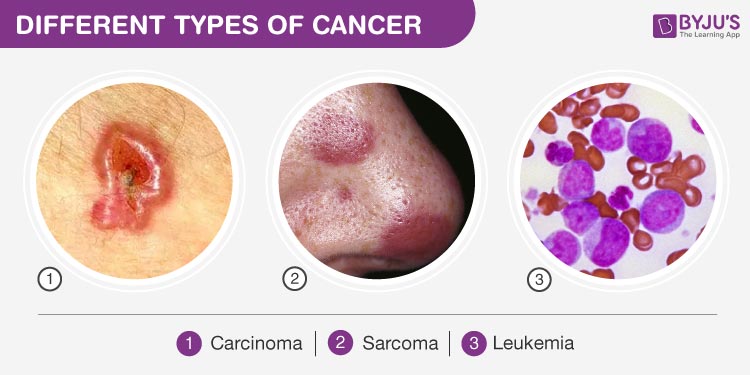Table of Contents
Introduction
Cancer is a serious disease in which the cells start dividing abnormally in an uncontrolled manner.
Most cancer cells are found in the shape of tumours, with a few notable exceptions such as leukaemia. All tumours are not cancerous. Some tumours, such as moles, stop growing and are not malignant.
Let us have a detailed look at the different types of cancer.
Types of Cancer
There are more than a hundred different types of cancer that are characterized by abnormal cell growth. Listed here are a few types of cancer:

Carcinoma
It is the most common form of cancer that affects the epithelial cells which form the lining of internal organs or the skin.
Lung cancer, skin cancer, pancreatic cancer and ovarian cancer are some of its common manifestations. Carcinomas can be identified by the different cells that they affect:
- Adenocarcinoma – A form of carcinoma that affects mucus or fluid-forming epithelial cells. Common examples of adenocarcinoma are breast cancer, colon cancer, and prostate cancer.
- Squamous Carcinoma- A carcinoma that affects the epithelial cells which are present beneath the outermost surface of the skin. These cells also form the lining of many vital organs in the human body such as the stomach, kidneys, lungs, intestines, and bladder.
- Basal Cell Carcinoma– A type of carcinoma that affects the basal cells found in the deepest layer of the epidermis. It is a form of skin cancer which appears as a lump or ulcer in the affected areas.
- Transitional cell carcinoma – It affects cells of transitional epithelium found in the lining of the bladder, ureters and certain parts of the kidney.
Also Read: Skin Cancer
Sarcoma
These cancer cells develop in the bones and soft tissues such as fat tissues, cartilages, blood vessels, lymph and other supporting tissues of tendons and ligaments.
The most common form of sarcoma in the bone is osteosarcoma, and in soft tissues include Kaposi sarcoma, liposarcoma, malignant fibrous histiocytoma, leiomyosarcoma, and dermatofibrosarcoma protuberans.
Leukaemia
Commonly known as blood cancer, leukaemia affects the tissues of the bone marrow which is responsible for blood production. It is one of the fatal forms of cancer.
Leukaemia is completely different from other types of cancer. It is caused by the uncontrolled production of white blood cells (Lymphoid cells and myeloid cells). These abnormal white blood cells damage the tissues of the bone marrow and crowd the normal blood cells. These abnormal white blood cells continue to divide and damage the complete normal blood cells. As a result, the Leukemia patient fails to provide adequate red blood cells to supply oxygen, adequate normal white blood cells to fight infections and adequate platelets for blood coagulation.
Lymphoma
Lymphoma is a form of cancer that affects the lymphocytes in the lymph nodes, which are a part of the immune system. There are two kinds of lymphoma:
- Hodgkin lymphoma – originates in the B cells
- Non-Hodgkin lymphoma, – originates in B or T cells.
Melanoma
It is a form of skin cancer that targets melanin – the pigment responsible for skin colour. In this form of cancer, the melanocytes are affected resulting in the abnormal formation of melanin. It may also affect other tissues that are pigmented, such as the eyes.
Myeloma
Myeloma targets another part of the immune system- the plasma cells. The affected plasma cells, called myeloma cells divide in the bone marrow causing multiple tumours in the bones (Multiple Myeloma also called Kahler disease).
CNS Cancers
CNS (Central Nervous System) cancers originate from the brain and the spinal cord. Gliomas, vestibular schwannomas, meningiomas, primary CNS lymphomas, pituitary adenomas, and primitive neuroectodermal tumours are a few CNS cancers.
Also Read: Lung Cancer
Symptoms of Cancer
Cancer can be identified by a variety of symptoms. In some cases, symptoms could vary or may not show any signs and symptoms. There are a few general symptoms:
- Irregular loss of weight
- Recurrent fever
- Continuous pain in a certain area
- Fatigue
- Irregular changes in the skin (pigmentation, unusual hair growth, red or yellow skin, blotches etc.)
Apart from these, women should watch out for certain symptoms of the cancers that are unique to them:
- Change in the shape or color of the breast
- Bleeding out of the menstrual cycle period
- Bloating
- Blood in stool
Causes of Cancer
Like symptoms, there is no conclusive evidence for its causes. However, scientists have found certain things which aggravate the occurrence of this disease. Some of the common factors are:
- Genetics
- Tobacco and other related narcotics
- Alcohol
- Exposure to unnatural radiation (such as UV rays) for an extended period of time
- Diet and lifestyle
- Exposure to certain chemicals for a long time
- Infections
- Unhealthy environment
Also Read: Blood Cancer
Treatment of Cancer
Medical science has advanced greatly in the last few decades and found the treatment for most forms of cancers. The process of treatment depends on the type and stages of cancer. Some of the common treatment includes surgery, chemotherapy, hormonal therapy, immunotherapy, and radiation therapy.
For more detailed information on different types of cancer, keep visiting BYJU’S website.

Comments